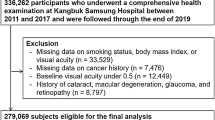Abstract
Objective
The issue of light at night and cancer continuously attracts discussion. The major hypotheses are that melatonin may decrease risk of hormone-related cancers, particularly breast cancer, or even act as a potent antioxidant and thus have a protective effect against cancer development in general.
Methods
We tested the hypothesis that blind persons are at lower risk of cancer in a follow-up study linking a cohort of 17,557 persons with visual impairment identified from the Finnish Register of Visual Impairment with cancer incidence data of the Finnish Cancer Registry for years 1983–2003.
Results
Breast cancer risk in females decreased by degree of visual impairment, and a similar but less consistent trend was observed for prostate cancer in males. The incidence for the remaining cancers among nearly to totally blind persons was significantly higher than in average Finnish population.
Conclusions
Our findings add to the suggestive epidemiological evidence for a decreased risk of hormone-related cancers in people with visual impairment and, consequently, a relationship between visible light at night and breast cancer risk. The result is strongly against the hypothesis of a systemic protective effect related lack of visible light.
Similar content being viewed by others
References
Stevens RG (1987) Electric power use and breast cancer: a hypothesis. Am J Epidemiol 25:556–561
Hahn RA (1991) Profound bilateral blindness and the incidence of breast cancer. Epidemiology 2:208–210
Feychting M, Österlund B, Ahlbom A (1998) Reduced cancer incidence among the blind. Epidemiology 9:490–494
Reiter RJ, Melcheorri D, Sewerynek E, et al. (1995) A review of the evidence supporting melatonin’s role as an antioxidant. J Pineal Res 18:1–11
Pukkala E, Verkasalo PK, Ojamo M, Rudanko S-L (1999) Visual impairment and cancer:a population-based cohort study in Finland. Cancer Causes Control 10:13–20
Verkasalo PK, Pukkala E, Stevens RG, Ojamo M, Rudanko S-L (1999) Inverse association between breast cancer incidence and degree of visual impairment in Finland. Brit J Cancer 80:1459–1460
Teppo L, Pukkala E, Lehtonen M (1994) Data quality and quality control of a population-based cancer registry. Experience in Finland. Acta Oncol 33:365–369
Pukkala E (1992) Use of record linkage in small-area studies. In: Elliot P, Guzick J, English D, Stern R (eds) Geographical and Environmental Epidemiology. Oxford University Press, Oxford, pp 125–131
Kliukiene J, Tynes T, Andersen A (2001) Risk of breast cancer among Norwegian women with visual impairment. Brit J Cancer 84:397–399
Henderson BE, Pike MC, Bernstein L, et al. (1996) Breast cancer. In: Schottenfeld D, Fraumeni JFJ (eds) Cancer Epidemiology and Prevention 2nd edn. Oxford University Press, New York, pp 1022–1039
Hartikainen R, Kuoppala T, Ojamo M (1998) Elintapoja muisteltiin tutkijoiden hyödyksi [Life style of the visually impaired] [In Finnish] Airut 87:872–873
Blask DE, Pelletier DB, Hill SM, et al. (1991) Pineal melatonin inhibition of tumor promotion in the N-nitroso-N-methylurea model of mammary carcinogenesis: potential involvement of antiestrogenic mechanisms in vivo. J Cancer Res Clin Oncol 117:526–532
Baldwin WS, Barret JC (1998) Melatonin:receptor-mediated events that may affect breat and other steroid hormone dependent cancers. Mol Carcinogen 21:149–155
Pukkala E, Aspholm R, Auvinen A, et al. (2003) Cancer incidence among 10,211 airline pilots:A Nordic study Aviat Space Environ Med 74:699–706
Author information
Authors and Affiliations
Corresponding author
Rights and permissions
About this article
Cite this article
Pukkala, E., Ojamo, M., Rudanko, SL. et al. Does Incidence of Breast Cancer and Prostate Cancer Decrease with Increasing Degree of Visual Impairment. Cancer Causes Control 17, 573–576 (2006). https://doi.org/10.1007/s10552-005-9005-6
Issue Date:
DOI: https://doi.org/10.1007/s10552-005-9005-6




